I'm getting a lot of commentary mileage out of the May CPI report. On Wednesday, I wrote about the CPI data themselves. On Thursday, I wrote about CPI-adjusted retail sales, noting how weak they are in the second quarter. And today, I will pen a comment about the CPI-adjusted M2 money supply. Chart 1 shows the year-over-year percent change in this version of real M2. In May, the year-over-year growth retreated to 0.55% from its recent peak in April of 1.34%. At 1.34%, real M2 growth is weak. At 0.55%, real M2 growth is downright anemic. In Q4:2000, just before the onset of the 2001 recession, year-over-year CPI-adjusted M2 growth was 2.55%. I know that real M2 growth is now considered passé as an indicator of monetary policy or as a leading indicator. The Fed never mentions it, not even St. Louis Fed President Poole, a former member of the monetarist Shadow Open Market Committee. But for some odd reason the Conference Board chooses to keep PCE-price-adjusted M2 money supply in its index of Leading Economic Indicators. I suppose the odd reason is because the correlation between the Conference Board's real M2 growth and real GDP growth is a not-too-shabby 0.60% (see Chart 2). So, we've got real M2 growth and the flat yield curve both suggesting that monetary policy is restrictive and the Fed on June 29 will raise the funds rate again. I can hardly wait to see how fast and by how much the consensus lowers its second-half real GDP growth forecasts after the advance Q2 real GDP data are released.
Chart 1
Chart 2
The Chinese Central Bank Joins The Tightening Club
Today the People's Bank of China (PBOC) announced that it was raising bank reserve requirements by one-half percent. Assuming that the PBOC does not create the extra reserves that will be demanded because of the increase in required reserves, Chinese monetary policy will have effectively been tightened. Unlike in the U.S., the Chinese central bankers do pay attention to money supply growth. After slowing to "only" about 14% in the second half of 2004 and the first half of 2005, Chinese M2 growth has since re-accelerated to the 18% to 19% range (see Chart 3). The Chinese government imposes price ceilings on a lot of goods, so reported Chinese consumer inflation remains low - less than 1-1/2%. But effective consumer price inflation is undoubtedly high. In addition, there is inflation in real estate - asset price inflation. The PBOC also is concerned that easy credit conditions are contributing to economically unjustified municipal investment activity. Skilled labor shortages are developing and the rising costs of raw materials are eating into corporate profit margins. In short, the Chinese economy is overheated because of cheap central bank credit. I would not be too surprised if this reserve requirement hike is the prelude to some significant revaluation of the yuan. If so, this could lead to some generalized weakening of the dollar in relation to other Asian currencies. In turn, this could complicate Fed policy over the remainder of the year in that a significantly weaker dollar might prevent or terminate early a Fed pause.
Chart 3
The Real News In The U. of M. Attitudes Survey
The University of Michigan released its preliminary June survey of consumer attitudes. Tomorrow's newspaper headlines will read something like:" Consumer Sentiment Rebounds in Early June." Chart 4 shows the month-to-month behavior of the index of Consumer Sentiment. Does the early-June rebound look significant to you? Can you even see the rebound from 79.1 to 82.4? Do you notice that the index remains below the nadir of the last recession? No, the real news is that consumers' inflation expectations decreased in early June. Their one-year ahead inflation expectations dropped from May's 4.0% to 3.4%. And their 10-year ahead inflation expectations dropped from May's 3.2% to 3.0%. As you recall, the Fed has been obsessed with inflation expectations of late, even mentioning how survey-based expectations had risen. Well, this survey is showing inflation expectations moving lower. Along with an economy that is losing altitude at a rapid rate, this backing off of consumers' expectations of inflation could be another argument for a Fed pause after it delivers its 17th consecutive FOMC meeting funds rate hike on June 29.
Chart 4
















